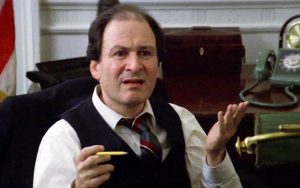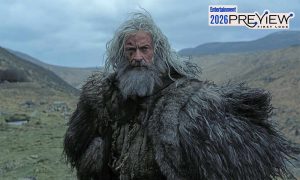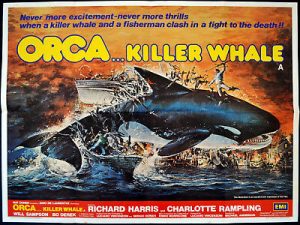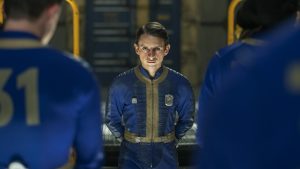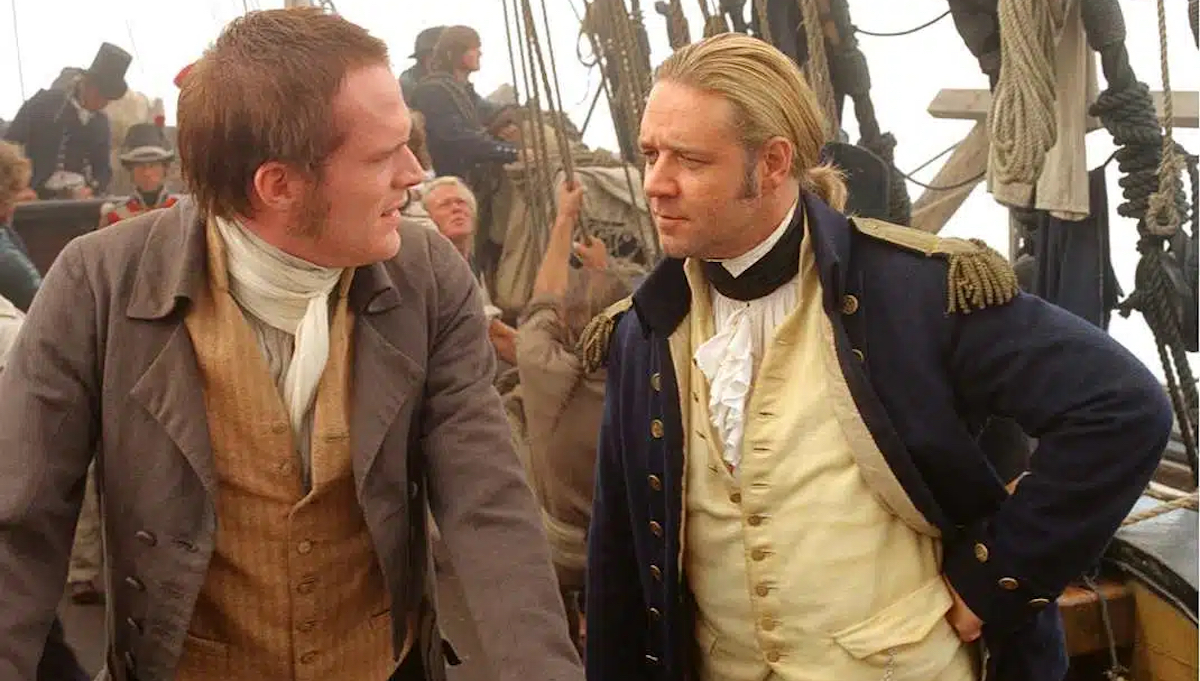
For a brief shining moment at the beginning of the 21st century, it seemed as though the historical epic was back. Despite the sniffs of some prominent film critics, Ridley Scott’s Gladiator walked away with the Best Picture Oscar in the century’s first year; a flood of sword and sandal epics invaded cinemas like the 1950s never ended; and it generally wasn’t a Russell Crowe movie unless the Australian thespian was waving a saber, cutlass, gladius, or other form of blade through the air.
Yet the movie which arguably stood tallest during this fleeting period was Peter Weir’s Master and Commander: The Far Side of the World. Not so much adapting any single novel in author Patrick O’Brian’s legendary Aubrey-Maturin book series, Weir pulled from close to a half-dozen tales in this saga set on the high seas during the Napoleonic Wars. Often celebrated for their historical authenticity and verisimilitude, O’Brian’s books invented a daring English naval captain named Jack Aubrey. Technically Lucky Jack is fictional, but many of his exploits were not, with O’Brian meticulously recreating some of the most cunning exploits engineered by the likes of Captain Lord Thomas Cochrane and Captain William Wolseley.
Rather than adapt a single one of O’Brian’s books, Weir and John Collee, who co-wrote the screenplay with Weir, drew upon nearly half of them in order to paint an epic cinematic portrait of life in the Royal Navy during the turn of the 19th century—back when Britain ruled the waves. It was this near-fanatical devotion to the historical details that has made Master and Commander the top of its class in 2000s historical epics, as well as a film that 20 years later has aged as finely as Captain Aubrey’s best port. Similarly, while the movie Weir ultimately made is largely crafted atop one of O’Brian’s most exciting stories, The Far Side of the World (1984), in which Aubrey’s HMS Surprise frigate finds itself in a cat-and-mouse chase with a faster, stronger ship out in the far Pacific, it is not the actual war of Weir’s film that makes it so compelling.
Master and Commander is a marvel for its highly specific attention to detail and delicacy. It’s a character study and slyly subtle upstairs/downstairs dramedy about the differences of lifestyles between officers and enlisted men; it is a fascinating window into what journalist David Grann called “the wooden world,” that universe which existed from bow to stern several centuries ago; and it is even an unlikely bromance between the surprisingly musical Aubrey and his penniless Irish surgeon Stephen Maturin (Paul Bettany).
Purely in terms of historical fiction, Master and Commander is an undeniable triumph and near masterpiece. Aye, we said near. Because while the level of research and passion Weir and his own armada of filmmakers poured into the film is unparalleled, there is the one amusing and unavoidable change that Weir and Collee were required to make when adapting O’Brian’s Far Side of the World novel that also pretty much breaks all credulity if you know anything about the naval warfare it depicts. And it needed to be done due to a fear that the actual historical context of Master and Commander’s source material might upset the sensitivities of American viewers. Bless their fragile hearts.
Not Your Great-Great-Grandfather’s Napoleonic Wars
In Master and Commander’s succinctly brutal opening title card, we are told it is the year 1805 and “NAPOLEON IS MASTER OF EUROPE. ONLY THE BRITISH FLEET STANDS BEFORE HIM. OCEANS ARE NOW BATTLEFIELDS.” It’s arguably the most gripping opening text since Star Wars, and it gears you up to immediately be on high alert as we are also quickly informed by way of naval dispatch that the HMS Surprise has orders to intercept and capture a privateer ship called the Acheron, a French vessel that inexplicably has sailed to the literal far side of the world in order to make war on British merchants. The Napoleonic Wars, it seems, will now be fought on the wrong side of Cape Horn.
It’s all very dramatic, but it does not make total strategic or historical sense. The latter becomes pronounced too after the opening sequence reveals the Acheron is able to get the jump on the Surprise and take seemingly heavy damage from the British vessel’s cannon fire without slowing down. In the modern parlance, the Acheron is the Terminator of 19th century ships, and Jack’s Surprise has suddenly transformed from predator to prey.
The reason the Acheron is so otherworldly to the Royal Navy is eventually explained by a crewman, who tells his captain he saw the Acheron being built in Boston and he was so stunned by the design he asked around about it. Soon enough he learned it was sheathed with a wood around its haul that apparently makes it faster. It’s a regular “Phantom” that can surprise the British at any time. The scary thing is the British Navy did contend with a ship like what is described in the movie, but it was not during the Napoleonic Wars. Aubrey’s Phantom instead came some years after Master and Commander’s 1805 setting, although it did indeed hail from Boston.
American Made
The USS Constitution, aka “Old Ironsides,” was first launched into the waters of Massachusetts Bay in 1797 and was one of six cutting edge frigates designed for the burgeoning U.S. Navy during the presidency of George Washington. However, it was not until the War of 1812 that the Constitution earned its Old Ironsides nickname—at the expense and embarrassment of the British Navy.
During that brutal if truncated conflict (which in part occurred due to the less-than-sanguine practice of the Royal Navy toward American sailors), the USS Constitution found itself in a life or death struggle with the British’s HMS Guerriere on the morning of Aug. 19, 1812. The Guerriere had been sent to make war on American vessels around New England, and not far from Boston it engaged with the Constitution… and saw its cannon fire bounce harmlessly off the Constitution’s haul before vanishing into the water.
This was made possible because unlike most early 19th century warships—British, American, or French—the Constitution’s haul was made from a combination of white oak and live oak. Most naval vessels of this era were built purely from white oak, which would shatter under the pressure of cannon fire. In contrast, live oak, a natural resource that was in heavy abundance in the American South, was stronger and more durable because of its resistance to moisture (a handy feature for the building materials of a sailing vessel). That resistance allowed it to move faster through water as well as resist a greater extent of outside pressure.
In the War of 1812, it allowed the USS Constitution to defy the Guerriere’s cannon blast before dismantling the English vessel with relative ease. Afterward, the ship was rechristened “Old Ironsides” for its seeming indestructibility, and it entered the realm of legend. In other words, it would make for a perfect enemy vessel in a story about an older British frigate which suddenly finds itself playing David against an enemy of the future’s Goliath.
Such a French Thing to Do
When O’Brian wrote The Far Side of the World, he was evidently trying to imagine how Lucky Jack would do against Old Ironsides, or a ship just like it. So he created a scenario where during the same war—which occurred between the many starts and stops of Britain’s conflicts with Napoleonic France—a fictional American ship called the USS Norfolk had begun targeting British Whalers in the far Pacific. Aubrey was thus sent to do battle with an American ship of superior design that outclassed the Surprise in every aspect, save perhaps for the shrewdness of its captain.
It’s a perfect setup for a movie, too, with the British Navy facing their phantom; a terminator on sails. However, to faithfully adapt O’Brian’s story, as well as the historical context in which such a conflict could be possible, it would mean that the American Navy would have to be the bad guys—or at least the respected adversary of the film’s heroes.
“The Americans would never back a film in which they were the enemy,” Weir said on the 2004 Master and Commander DVD’s special features. “It was just confusing emotionally for the audience. Who did they feel for? Jack or their own countrymen?” Ultimately, the director recalled with the faintest hints of a smirk on his face that “given it was an American-backed picture, it was asking too much.”
So the events of The Far Side of the World were moved from the War of 1812 to an earlier period of Britain’s frequent bouts of naval warfare with France. In early 1805, the French Navy had not been definitively routed by the British during the Battle of Trafalgar, and Lucky Jack would still be tangling with the forces of Bonaparte, an enemy American audiences could happily cheer against.
However, it doesn’t make clear sense how the French Navy, or even privateers working on behalf of the French Navy, had come into the possession of an “ironside” ship that was constructed in Boston. Admittedly, foreign vessels could be commandeered after a battle. The HMS Guerriere, in fact, was a French vessel captured by the British. But the entire point of O’Brian’s story is to imagine a scenario where superior American naval technology could be outmaneuvered by a witty English captain, and we doubt the film wishes you to think the French have already defeated and commandeered this “phantom” from the yankees.
In truth, it makes little sense at all that the Acheron could exist in any context other than it was easier for Master and Commander to be financed by 20th Century Fox (and Universal and Miramax) if our heroes were swashbuckling and shooting at Frenchmen at the end instead of American sailors.
By no means does this diminish Master and Commander, one of the finest films ever made about naval life and the fellowship of man. It just remains a curious wrinkle where a film that strives so much for historical authenticity is forced to indulge in a historical impossibility purely so as to not upset overly delicate American sensibilities.
The post Master and Commander: A Perfect War Movie That Was Changed for Sensitive Americans appeared first on Den of Geek.




